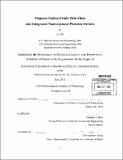| dc.contributor.advisor | Caroline A. Ross. | en_US |
| dc.contributor.author | Bi, Lei, Ph.D. Massachusetts Institute of Technology | en_US |
| dc.contributor.other | Massachusetts Institute of Technology. Dept. of Materials Science and Engineering. | en_US |
| dc.date.accessioned | 2012-03-16T16:03:06Z | |
| dc.date.available | 2012-03-16T16:03:06Z | |
| dc.date.copyright | 2011 | en_US |
| dc.date.issued | 2011 | en_US |
| dc.identifier.uri | http://hdl.handle.net/1721.1/69786 | |
| dc.description | Thesis (Ph. D.)--Massachusetts Institute of Technology, Dept. of Materials Science and Engineering, 2011. | en_US |
| dc.description | Cataloged from PDF version of thesis. | en_US |
| dc.description | Includes bibliographical references. | en_US |
| dc.description.abstract | Nonreciprocal photonic devices including optical isolators and optical circulators are indispensible components in present day optical communication systems. Although highly desired by the fast development of silicon photonics, monolithically integrating such devices on a semiconductor platform has been challenging for decades both due to material incompatibility and device designs. In this thesis, we focus on developing material and device candidates for monolithically integrated nonreciprocal photonic devices on silicon. Several magneto-optical oxide thin films including epitaxial magnetically doped perovskites and polycrystalline garnets were demonstrated with high figure of merit at communication wavelengths, while epitaxial orthoferrite films were understood to have challenges in achieving either thermodynamically limited cation ordering or kinetically limited single crystal orientations. High figure of merits of 3~4 deg/dB and 20 deg/dB were achieved in epitaxial Sr(Tio.2Gao.Feo.4)0 3 films and in polycrystalline (CeY2)FesO 12 films stabilized by a thin Y3Fe5O12 polycrystalline layer on oxidized silicon respectively. Based on these materials, novel photonic devices including nonreciprocal strip-loaded waveguides and resonators were simulated and experimentally demonstrated. Strong nonreciprocal phase shift (NRPS) has been demonstrated in chalcogenide glass/magnetic oxide and magnetic oxide/silicon strip-loaded waveguides by numerical simulations. A nonreciprocal optical racetrack resonator based on polycrystalline garnet/silicon strip-loaded waveguides was experimentally demonstrated. This monolithically integrated device showed ~10 times footprint reduction compared to conventional nonreciprocal photonic device designs, which may serve as a fundamental structure in a variety of ultra compact photonic devices such as optical isolators, circulators, switches and modulators in the future. | en_US |
| dc.description.statementofresponsibility | by Lei Bi. | en_US |
| dc.format.extent | 183 p. | en_US |
| dc.language.iso | eng | en_US |
| dc.publisher | Massachusetts Institute of Technology | en_US |
| dc.rights | M.I.T. theses are protected by
copyright. They may be viewed from this source for any purpose, but
reproduction or distribution in any format is prohibited without written
permission. See provided URL for inquiries about permission. | en_US |
| dc.rights.uri | http://dspace.mit.edu/handle/1721.1/7582 | en_US |
| dc.subject | Materials Science and Engineering. | en_US |
| dc.title | Magneto-optical oxide thin films and integrated nonreciprocal photonic devices | en_US |
| dc.title.alternative | Magneto-optical materials and devices for integrated optical isolator applications | en_US |
| dc.type | Thesis | en_US |
| dc.description.degree | Ph.D. | en_US |
| dc.contributor.department | Massachusetts Institute of Technology. Department of Materials Science and Engineering | |
| dc.identifier.oclc | 777362068 | en_US |
